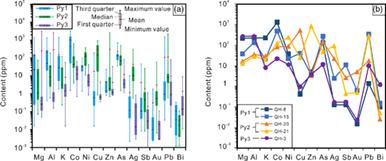当前位置:
X-MOL 学术
›
Geolog. J.
›
论文详情
Our official English website, www.x-mol.net, welcomes your feedback! (Note: you will need to create a separate account there.)
Genesis of hydrothermal gold mineralization in the Qianhe deposit, central China: Constraints from in situ sulphur isotope and trace elements of pyrite
Geological Journal ( IF 1.8 ) Pub Date : 2021-02-15 , DOI: 10.1002/gj.4099 Jia‐Ying Feng 1, 2 , Li Tang 1, 2 , M. Santosh 1, 3 , Shou‐Ting Zhang 1 , Yuan‐Ming Sheng 1 , Xin‐Kai Hu 1 , Liang Wang 1
Geological Journal ( IF 1.8 ) Pub Date : 2021-02-15 , DOI: 10.1002/gj.4099 Jia‐Ying Feng 1, 2 , Li Tang 1, 2 , M. Santosh 1, 3 , Shou‐Ting Zhang 1 , Yuan‐Ming Sheng 1 , Xin‐Kai Hu 1 , Liang Wang 1
Affiliation

|
The Qianhe gold deposit, located at Xiong'ershan in Eastern Qinling, with estimated gold reserves of 22 tons, hosts six orebodies within auriferous quartz veins and hydrothermally-altered rocks along E–W trending faults. Here we present results from an integrated study involving field investigation, ore petrology, in situ sulphur isotopes, and trace elements analysis of gold-bearing pyrite with a view to understanding the genesis of the hydrothermal gold mineralization. Three generations of pyrite are identified in the Qianhe Au deposit: Py1 is composed of coarse-grained, euhedral cubic grains occurring at the margin of stage I quartz + pyrite vein; Py2 is occurs as porous grains coexisting with other sulphide minerals in stage II quartz + polymetallic sulphide veins; and Py3 is mainly composed of anhedral grains in stage III quartz + calcite + fluorite vein. Among the three generations, Py2 has the highest contents of Au (mean = 3.5 ppm), Ag (mean = 46.0 ppm), Zn (mean = 303 ppm), and Cu (mean = 346 ppm). The distribution and concentration of these trace elements are likely to be controlled by micro/nano-inclusions in pyrite. The Co/Ni ratios range from 0.010 to 296, with most values lying between 0.1 and 10. The δ34S values of the various pyrite generations show a wide range between −17.9‰ and 4.5‰ with obviously higher values in Py3 (2.0‰ to 4.5‰) than those in Py1 (−16.7‰ to −13.5‰) and Py2 (−17.9‰ to −9.0‰). The negative δ34S values in Py1 and Py2 possibly resulted from sulphur isotope fractionation between sulphide and sulphate minerals. As sulphate minerals are absent in stage III, the slightly positive δ34S values in Py3 suggest a mixed source from mantle-derived material and wall rocks of the Xiong'er Group. We correlate the genesis of gold mineralization in the Qianhe deposit with the extension and lithospheric thinning during Early Cretaceous, when ore-bearing fluids channelled along fault zones induced hydrothermal alteration and Au mineralization.
中文翻译:

华中千河矿床热液金成矿成因:原位硫同位素和黄铁矿微量元素的约束
千河金矿床位于东秦岭熊耳山,估计金储量为22吨,在含金石英脉和沿东西向断层的热液蚀变岩中拥有6个矿体。在这里,我们展示了一项综合研究的结果,该研究涉及现场调查、矿石岩石学、原位硫同位素和含金黄铁矿的微量元素分析,以期了解热液金矿化的成因。千河金矿床共鉴定出三代黄铁矿:Py1由粗粒自形立方晶粒组成,分布于Ⅰ期石英+黄铁矿脉边缘;Py2 以多孔颗粒形式与其他硫化物矿物共存于 II 期石英+多金属硫化物脉中;Py3主要由III期石英+方解石+萤石脉中的自面体颗粒组成。三代中,Py2的Au(平均值= 3.5 ppm)、Ag(平均值= 46.0 ppm)、Zn(平均值= 303 ppm)和Cu(平均值= 346 ppm)的含量最高。这些微量元素的分布和浓度很可能受黄铁矿中微/纳米包裹体的控制。Co/Ni 比率范围从 0.010 到 296,大多数值介于 0.1 和 10 之间。 δ34硫铁矿各代的 S 值在 -17.9‰ 和 4.5‰ 之间的范围很广,其中 Py3(2.0‰ 到 4.5‰)的值明显高于 Py1(-16.7‰ 到 -13.5‰)和 Py2(-17.9 ‰ 到 -9.0‰)。Py1 和 Py2 中的负 δ 34 S 值可能是由于硫化物和硫酸盐矿物之间的硫同位素分馏造成的。由于第三阶段不存在硫酸盐矿物,Py3 中略为正的 δ 34 S 值表明来自地幔物质和熊耳群围岩的混合来源。我们将前河矿床中金矿化的成因与早白垩世期间岩石圈的伸展和减薄相关联,当时沿断裂带引导的含矿流体诱发了热液蚀变和金矿化。
更新日期:2021-02-15
中文翻译:

华中千河矿床热液金成矿成因:原位硫同位素和黄铁矿微量元素的约束
千河金矿床位于东秦岭熊耳山,估计金储量为22吨,在含金石英脉和沿东西向断层的热液蚀变岩中拥有6个矿体。在这里,我们展示了一项综合研究的结果,该研究涉及现场调查、矿石岩石学、原位硫同位素和含金黄铁矿的微量元素分析,以期了解热液金矿化的成因。千河金矿床共鉴定出三代黄铁矿:Py1由粗粒自形立方晶粒组成,分布于Ⅰ期石英+黄铁矿脉边缘;Py2 以多孔颗粒形式与其他硫化物矿物共存于 II 期石英+多金属硫化物脉中;Py3主要由III期石英+方解石+萤石脉中的自面体颗粒组成。三代中,Py2的Au(平均值= 3.5 ppm)、Ag(平均值= 46.0 ppm)、Zn(平均值= 303 ppm)和Cu(平均值= 346 ppm)的含量最高。这些微量元素的分布和浓度很可能受黄铁矿中微/纳米包裹体的控制。Co/Ni 比率范围从 0.010 到 296,大多数值介于 0.1 和 10 之间。 δ34硫铁矿各代的 S 值在 -17.9‰ 和 4.5‰ 之间的范围很广,其中 Py3(2.0‰ 到 4.5‰)的值明显高于 Py1(-16.7‰ 到 -13.5‰)和 Py2(-17.9 ‰ 到 -9.0‰)。Py1 和 Py2 中的负 δ 34 S 值可能是由于硫化物和硫酸盐矿物之间的硫同位素分馏造成的。由于第三阶段不存在硫酸盐矿物,Py3 中略为正的 δ 34 S 值表明来自地幔物质和熊耳群围岩的混合来源。我们将前河矿床中金矿化的成因与早白垩世期间岩石圈的伸展和减薄相关联,当时沿断裂带引导的含矿流体诱发了热液蚀变和金矿化。



























 京公网安备 11010802027423号
京公网安备 11010802027423号